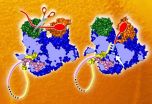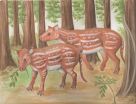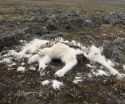(Press-News.org) If you planned to sabotage a factory, a recon trip through the premises would probably be much more useful than just peeping in at the windows. Scientists looking to understand - and potentially thwart - the influenza virus have now gone from a similar window-based view to the full factory tour, thanks to the first complete structure of one of the flu virus' key machines. The structure, obtained by scientists at the European Molecular Biology Laboratory (EMBL) in Grenoble, France, allows researchers to finally understand how the machine works as a whole. Published today in two papers in Nature, the work could prove instrumental in designing new drugs to treat serious flu infections and combat flu pandemics.
The machine in question, the influenza virus polymerase, carries out two vital tasks for the virus. It makes copies of the virus' genetic material - the viral RNA - to package into new viruses that can infect other cells; and it reads out the instructions in that genetic material to make viral messenger RNA, which directs the infected cell to produce the proteins the virus needs. Scientists - including Stephen Cusack and collaborators - had been able to determine the structure of several parts of the polymerase in the past. But how those parts came together to function as a whole, and how viral RNA being fed in to the polymerase could be treated in two different ways remained a mystery.
"The flu polymerase was discovered 40 years ago, so there are hundreds of papers out there trying to fathom how it works. But only now that we have the complete structure can we really begin to understand it," says Stephen Cusack, head of EMBL Grenoble, who led the work.
Using X-ray crystallography, performed at the European Synchrotron Radiation Facility (ESRF) in Grenoble, Cusack and colleagues were able to determine the atomic structure of the whole polymerase from two strains of influenza: influenza B, one of the strains that cause seasonal flu in humans, but which evolves slowly and therefore isn't considered a pandemic threat; and the strain of influenza A - the fast-evolving strain that affects humans, birds and other animals and can cause pandemics - that infects bats.
"The high-intensity X-ray beamlines at the ESRF, equipped with state-of-the-art Dectris detectors, were crucial for getting high quality crystallographic data from the weakly diffracting and radiation sensitive crystals of the large polymerase complex," says Cusack. "We couldn't have got the data at such a good resolution without them".
The structures reveal how the polymerase specifically recognises and binds to the viral RNA, rather than just any available RNA, and how that binding activates the machine. They also show that the three component proteins that make up the polymerase are very intertwined, which explains why it has been very difficult to piece together how this machine works based on structures of individual parts.
Although the structures of both viruses' polymerases were very similar, the scientists found one key difference, which showed that one part of the machine can swivel around to a large degree. That ability to swivel explains exactly how the polymerase uses host cell RNA to kick-start the production of viral proteins. The swivelling component takes the necessary piece of host cell RNA and directs it into a slot leading to the machine's heart, where it triggers the production of viral messenger RNA.
Now that they know exactly where each atom fits in this key viral machine, researchers aiming to design drugs to stop influenza in its tracks have a much wider range of potential targets at their disposal - like would-be saboteurs who gain access to the whole production plant instead of just sneaking looks through the windows. And because this is such a fundamental piece of the viral machinery, not only are the versions in the different influenza strains very similar to each other, but they also hold many similarities to their counterparts in related viruses such as lassa, hanta, rabies or ebola.
The EMBL scientists aim to explore the new insights this structure provides for drug design, as well as continuing to try to determine the structure of the human version of influenza A, because although the bat version is close enough that it already provides remarkable insights, ultimately fine-tuning drugs for treating people would benefit from/require knowledge of the version of the virus that infects humans. And, since this viral machine has to be flexible and change shape to carry out its different tasks, Cusack and colleagues also want to get further snapshots of the polymerase in different states.
"This doesn't mean we now have all the answers," says Cusack, "In fact, we have as many new questions as answers, but at least now we have a solid basis on which to probe further."
INFORMATION:
The work was carried out on the ESRF's ID23-1 beamline. The study was conducted within the joint Unit of Virus-Host Cell Interactions (UVHCI), a collaboration between EMBL, the Centre National de la Recherche Scientifique (CNRS) and the Grenoble University Joseph Fourier. The work was funded by an Advanced Investigator grant from the European Research Council (ERC) to Stephen Cusack and by the EU-funded project FluPHARM.
Shedding pounds is all the rage these days and the global trend toward weight reduction has even spread to the automobile industry. Cars are to get even lighter - using new materials such as ultra-high-strength steels or carbon, and carbon-fiber-reinforced plastics (CFRP). But no matter which diet regime and which lightweight components manufacturers choose, they all want the same thing: the best and longest-lasting joining method for vehicle components. Since Duroplast, which often serves as the matrix component for CFRPs, can't be welded, another joining technique is ...
China has made significant progress increasing access to tap water and sanitation services, and has sharply reduced the burden of waterborne and water-related infectious diseases over the past two decades. However, in a study published in the latest edition of Nature Climate Change, researchers from Emory University found that climate change will blunt China's efforts at further reducing these diseases in the decades to come.
The study found that by 2030, changes to the global climate could delay China's progress reducing diarrheal and vector-borne diseases by up to seven ...
Faced with declining enrollment and rising costs, some small liberal arts colleges have added professional and vocational majors, a decision University of Iowa researchers say has strengthened rather than undermined the mission of the schools.
In fact, students at liberal arts colleges realized virtually the same educational gains, no matter their major, according to the UI report released earlier this month. The only differences were liberal arts major expressed a greater interest in literacy while professional majors scored higher in leadership skills.
"Essentially, ...
A collaborative team of leaders in the field of cancer immunology from Memorial Sloan Kettering Cancer Center has made a key discovery that advances the understanding of why some patients respond to ipilimumab, an immunotherapy drug, while others do not. MSK was at the forefront of the clinical research that brought this CTLA-4 blocking antibody to melanoma patients.
A report published online first today in the New England Journal of Medicine shows that in patients who respond to ipilimumab, their cancer cells carry a high number of gene mutations--some of which make ...
Barcelona, Spain: Patients with a form of advanced colorectal cancer that is driven by a mutated version of the BRAF gene have limited treatment options available. However, results from a multi-centre clinical trial suggest that the cancer may respond to a combination of three targeted drugs.
Professor Josep Tabernero, head of the medical oncology department at Vall d'Hebron University Hospital and director of the Vall d'Hebron Institute of Oncology, Barcelona, Spain, will tell the 26th EORTC-NCI-AACR [1] Symposium on Molecular Targets and Cancer Therapeutics in Barcelona ...
(PHILADELPHIA) - Amyotrophic lateral sclerosis (ALS), also known as Lou Gehrig's disease, is a neurodegenerative disease that primarily kills motor neurons, leading to paralysis and death 2 to 5 years from diagnosis. Currently ALS has no cure. Despite promising early-stage research, the majority of drugs in development for ALS have failed. Now researchers have uncovered a possible explanation. In a study published November 20th in the Annals of Clinical and Translational Neurology, researchers show that the brain's machinery for pumping out toxins is ratcheted up in ALS ...
A lot of research has shown that poor regulation of the serotonin system, caused by certain genetic variations, can increase the risk of developing psychiatric illnesses such as autism, depression, or anxiety disorders. Furthermore, genetic variations in the components of the serotonin system can interact with stress experienced during the foetal stages and/or early childhood, which can also increase the risk of developing psychiatric problems later on.
In order to better understand serotonin's influence in the developing brain, Alexandre Dayer's team in the Psychiatry ...
Working at the edge of a coal mine in India, a team of Johns Hopkins researchers and colleagues have filled in a major gap in science's understanding of the evolution of a group of animals that includes horses and rhinos. That group likely originated on the subcontinent when it was still an island headed swiftly for collision with Asia, the researchers report Nov. 20 in the online journal Nature Communications.
Modern horses, rhinos and tapirs belong to a biological group, or order, called Perissodactyla. Also known as "odd-toed ungulates," animals in the order have, ...
Bremerhaven/Germany, 20 November 2014. Scientists from the Alfred Wegener Institute, Helmholtz Centre for Polar and Marine Research (AWI) have identified a possible source of carbon dioxide (CO2) and other greenhouse gases that were abruptly released to the atmosphere in large quantities around 14,600 years ago. According to this new interpretation, the CO2 - released during the onset of the Bølling/Allerød warm period - presumably had their origin in thawing Arctic permafrost soil and amplified the initial warming through positive feedback. The study now appears ...
The residents of Longyearbyen, the largest town on the Norwegian arctic island archipelago of Svalbard, remember it as the week that the weather gods caused trouble.
Temperatures were ridiculously warm - and reached a maximum of nearly +8 degrees C in one location at a time when mean temperatures are normally -15 degrees C. It rained in record amounts.
Snow packs became so saturated that slushy snow avalanches from the mountains surrounding Longyearbyen covered roads and took out a major pedestrian bridge.
Snowy streets and the tundra were transformed into icy, ...



